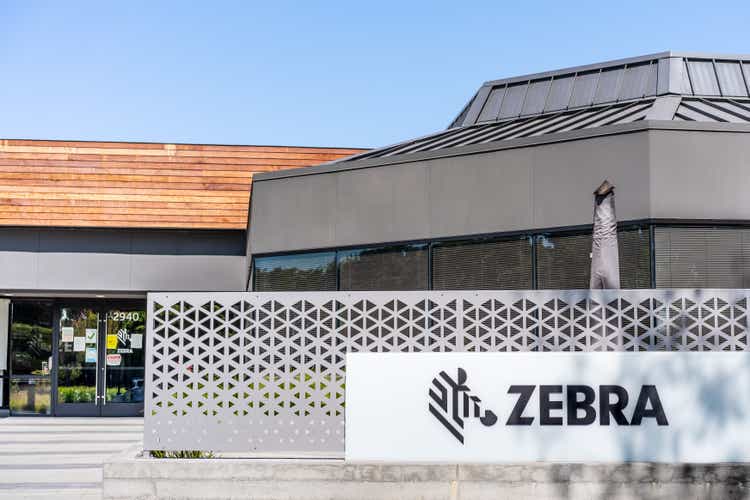
Sundry Photography Zebra Technologies ( NASDAQ: ZBRA ) has been on quite the run over the past year. The tech giant's stock jumped an impressive 23.5% year-to-date (YTD) , outpacing the S&P 500's 18% gain during the same period.
The powerful performance is linked to a rebound from tough comps and its healthy profitability profile. However, on the back of those impressive gains, the stock is now trading at over 76 times earnings, a valuation that isn't supported by its current earnings growth. Also, a sensitivity analysis shows the stock will need to grow its free cash flow per share by more than 25% annually over the next 10 years, an unlikely scenario based on its past performance.

Hence, that leaves investors with little margin for safety, making the stock one to avoid at current prices. Zebra Technologies: Company Snapshot Zebra Technologies, founded in 1969, provides solutions that help businesses effectively track, manage, and optimize assets using its robust data capture technologies. It currently employs 9,750 employees, with its market cap exceeding $17.
41 billion . Moreover, the company operates through two main segments, which include Enterprise Visibility & Mobility (EVM) and Asset Intelligence and Tracking (AIT). Its EVM segment constitutes roughly 64% of its total sales, generating $2.
9 billion. The segment essentially optimizes workflow through automation, data capture, and cloud-based software. Conversely, the AIT segment specializes in barcode printing and asset tracking, constituting 36% of total sales of $1.
7 billion. Zebra's products include RFID scanners and printers widely used in eCommerce, warehouses, and logistics to improve efficiency. ZBRA Operating Revenue by Geographic Region (Gurufocus) Moreover, from the snapshot above, we can see that the firm is well-diversified geographically.
The U.S. contributes approximately 50.
8% of its $4.58 billion revenue, while other regions, including Germany (14.9%), Europe, the Middle East, Africa (16%), and Asia-Pacific (10.
5%), also play significant roles. Latin America (6.2%) and North America outside the U.
S. underscore its global reach. Like many of its peers, the pandemic proved massive for Zebra's business.
The explosion of online shopping fueled an even greater demand for supply chain automation and asset-tracking solutions. 2021, in particular, was a standout year for the company, as businesses efficiently adapted to the surge in eCommerce and supply chain demands. Zebra's revenues reached $5.
63 billion, representing a 26.5% increase year-over-year (YOY), while earnings soared to $15.66 per share, reflecting the heightened demand for its RFID scanners and barcode printers.
Encouraging Earnings, But Concerns Still Linger Zebra Technologies has been navigating tough YOY comps following an impressive 2021, with an average revenue growth of 20% from Q1 to Q4. However, over the past year, we've seen it post encouraging results, marked by comfortable beats across both lines. Additionally, the firm is back in the green regarding revenue growth, posting a modest 0.
2% YOY increase in sales during Q2 this year. Notably, organic sales growth was still in the red at a negative 0.3%.
Additionally, segment-wise performance shows a 14.4% drop in sales for Zebra's AIT segment, which has been a key growth driver. This drop underscores that there's still plenty of work left to revitalize top-line growth near its historical averages.
Q2 Earnings Deck ZBRA Stock (Investor Relations Zebra Technologies) On the bottom-line front, Zebra Technologies delivered an impressive Q2 EPS of $3.18 , beating estimates by a superb 37 cents. Moreover, this effectively marks the firm's seventh consecutive quarterly earnings beat, with recent quarters seeing even larger beats.
During Q2, it posted a 1.4% increase in adjusted gross profit to $591 million, with margins jumping 60 basis points to 48.6%.
However, the growth in gross profits was offset by the drop in its adjusted EBITDA, which declined by 2.7%. As we look ahead, the company expects a strong Q3 showing, with sales forecasted to jump by 25% to 28% YOY .
Also, it projects an adjusted EBITDA margin of 20% to 21% and non-GAAP EPS between $3.00 and $3.30.
For FY24, sales growth is expected to be more modest, ranging from 4% to 7%. Additionally, the firm anticipates maintaining EBITDA margins between 20% and 21% for the full year, which aligns with Q3 projections. Earnings Surprise Estimates (Seeking Alpha) Furthermore, these projections on profitability are supported by analyst forecasts, which predict a substantial 270.
45% EPS surprise during Q3. However, a marked slowdown is anticipated afterward, with EPS surprise dropping to 104.56% in Q4 2024 and further decelerating into 2025, falling to 26.
45% in Q1 and 20.67% in Q2 2025 . Another major highlight of Zebra Technologies' Q2 report was its powerful liquidity statistics.
The firm holds a whopping $411 million in cash and cash equivalents, with a total debt load of around $2.2 billion. Additionally, Zebra also has $1.
5 billion available under its revolving credit facility while having generated $389 million in free cash flow during the first-half of 2024 due to lower tax payments, working capital improvements, and a $43 million debt paydown. Q2 Earnings Deck ZBRA Stock (Investor Relations Zebra Technologies) Though the firm has made encouraging strides, its debt-to-equity ratio of 0.731 and $2.
08 billion in net long-term debt remain elevated and near historical highs. Additionally, the burden of rising interest payments continues to rise rapidly, with interest cash paid jumping by 81% in 2023, 91% in 2024, and by a whopping 158% on a trailing twelve-month (TTM) basis. Hence, these numbers show that despite the headway, it still faces significant financial pressure.
Long Term Debt and Debt To Equity Ratio ZBRA Stock (YCharts) Current Valuation Leaves Very Little Margin For Error As discussed earlier, Zebra Technologies stock has been on a tear over the past year, beating its peers and the broader market by comfortable margins. The stock kicked off the year at approximately $267 and is now changing hands at $337.48, 13% higher than its average since the start of the year.
Consequently, ZBRA stock is trading near its historic high PE ratio of 76.18, trouncing its competition. The chart below shows that its PE ratio is significantly higher than its competition, raising major concerns over its valuation.
ZBRA Stock Price Performance Compared To Peers (YCharts) Moreover, we can track the bullishness in its stock price from November 2023 to May this year, underscoring strong investor confidence. From a technical perspective, ZBRA stock trades remarkably above the 9-period, 21-period, and 50-period EMAs, pointing to healthy momentum, but the broader picture urges caution. However, the MACD line (blue) sits below the signal line (yellow), suggesting the bullish momentum is weakening.
Additionally, the On-Balance-Volume (OBV) is relatively flat, which indicates that though the stock is rising, it lacks the buying volume needed to support its sustained growth. Hence, despite the stock trading above key EMAs, the lack of confirming volume and weakening momentum points to consolidation or a pullback before the next major move. ZBRA Stock Performance (TrendSpider) Additionally, a sensitivity analysis provides more insight into the potential valuation of ZBRA stock.
For that purpose, I calculated the firm's weighted average cost of capital (WACC), which came in at 12.46%, using an adjusted beta of 1.45.
This beta is based on 5 years of stock data and has been adjusted for beta drift, ensuring a clearer volatility picture. Moreover, the fair value calculation looks at the TTM FCF per share at $8.60 and key estimates based on a 4% terminal growth rate spanning 10 years from 2024 to 2034.
ZBRA Stock WACC Calculation (Author's Own Computation) ZBRA Stock Sensitivity Analysis (Author's Own Computation) Given the discount rate of around 12.46%, it will be a tall order for the company's current pricing to be justified. It needs to grow its FCF per share consistently between the 25% to 40% range, which seems implausible given the choppiness in its FCF per share growth over the years.
Over the past decade, the firm's FCF per share has fluctuated significantly, with values ranging from a substantial -58.14% drop to a remarkable 203.81% increase.
Risks To The Thesis Naturally, there is a strong possibility that Zebra Technologies could blow past its 52-week high, propelled by ongoing momentum. A major catalyst for the stock can be the upcoming interest rate cuts that can significantly bolster the electronic equipment and components industry. The lower borrowing costs enable businesses like Zebra Technologies to build on their expansion efforts, making tech products much more accessible.
Moreover, cheaper financing stimulates consumer and business spending, increasing the demand for electronic equipment and related technologies. Furthermore, recent reports have shown investors are significantly ramping up expectations for a half-percentage-point rate cut by the Federal Reserve in their upcoming meeting. Additionally, the likelihood of a half-point cut is now up 49% , a steep rise from 15% earlier.
Also, according to insights from Simply Wall St., analysts are bullish on the U.S.
electronic components' industry, expecting a remarkable annual earnings growth of 24% over the next five years. This is a major turnaround from the previous yearly earnings decline of 28%, signaling a promising outlook. Takeaway On Zebra Technologies Stock Zebra Technologies has been a winner at the stock market over the past year, outperforming the S&P 500 with a 23.
5% gain YTD driven by a recovery from difficult comps and strong profitability. However, its current valuation appears incredibly stretched, trading at more than 76 times earnings, which is tough to justify at this point. Moreover, a sensitivity analysis suggests that the firm will need to grow its FCF per share upwards of 25% annually over the next decade, which seems unlikely based on its track record.
Therefore, with the limited margin for safety at current levels, it's hard to get excited about the stock. Analyst’s Disclosure: I/we have no stock, option or similar derivative position in any of the companies mentioned, and no plans to initiate any such positions within the next 72 hours. I wrote this article myself, and it expresses my own opinions.
I am not receiving compensation for it (other than from Seeking Alpha). I have no business relationship with any company whose stock is mentioned in this article. Seeking Alpha's Disclosure: Past performance is no guarantee of future results.
No recommendation or advice is being given as to whether any investment is suitable for a particular investor. Any views or opinions expressed above may not reflect those of Seeking Alpha as a whole. Seeking Alpha is not a licensed securities dealer, broker or US investment adviser or investment bank.
Our analysts are third party authors that include both professional investors and individual investors who may not be licensed or certified by any institute or regulatory body..














